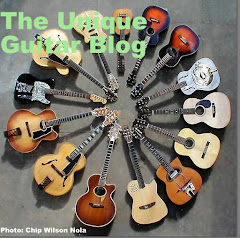They set up their original factory was at Michigan Avenue and Wabash Street in Chicago. They began to manufacture guitars, mandolins, ukuleles, harp guitars and zithers under the Washburn logo, using the middle name of Mr. Lyon. Washburn was house brand of music retail store.
During those days Chicago was a large industrial town and an important musical center. It was home to orchestras and dance bands, blues performers and WLS radio, which used live performers as entertainment. Of course this era was prior to the days of the dreadnaught guitar and even steel strings.
Most of Washburn's line was very well constructed using X bracing and Waverly tuners. Their model number 308 was elaborately inlaid and the wood was AAA. During it's day this was the most ornate guitar on the market. It had intricate pearl inlay work running along the outer body contours, rosette, fretboard and headstock.
 |
| Washburn Presentation |
WWI came along and in 1914 Lyon and Healy ceased manufacturing ornate instruments. Times were changing and so were music styles. Within a few years Jazz dance bands dominated and the tenor banjo was very popular.
Lyon and Healy produced a tenor guitar which was tuned exactly like a tenor banjo and had four strings and a longer neck. They also introduced what I think is their most unique instrument, the bell shaped guitar that had gold painted designs on the upper body. Another guitar, the shrine guitar was also produced.
By the end of the 1920's, both gentlemen had died and the company was sold to the Tonk Brothers. They were a large manufacturer and had many other lines of musical instruments.
So the quality of the Washburn brand deteriorated which lead to the brands decline.
Carl Sandburg, perhaps America's greatest poet, owned and played a Washburn Bell guitar.
The Washburn brand ame was acquired by an overseas manufacturer and continues to produce guitars manufactured in several far eastern countries. Lyon and Healy live on and produce fine concert harps.















No comments:
Post a Comment